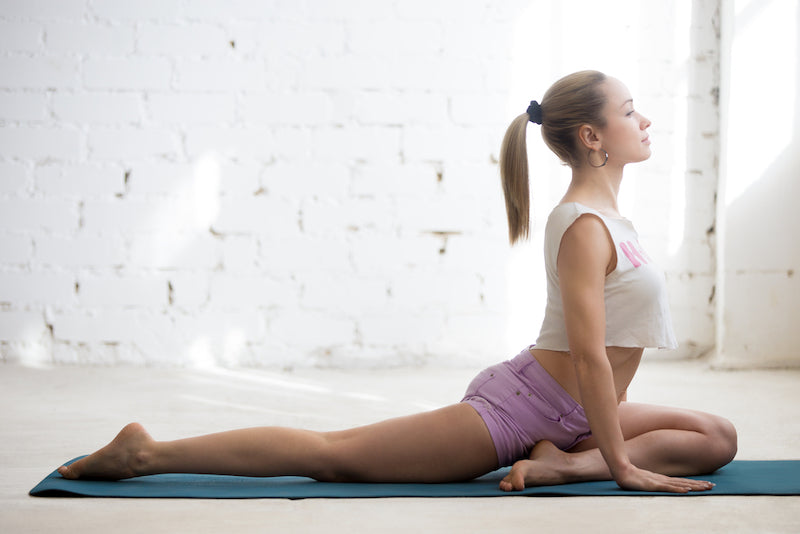
Whether you’re a serious athlete, fitness enthusiast, or casual gym-goer, stretching should be part of your workout routine. Stretching helps you improve flexibility and range of motion, and it reduces the chance of getting injured.
What a lot of people don’t realize, however, is that there are different types of stretching, serving different purposes and best done at a different stage of your workout.
These are static and dynamic stretching.
Read on and we’ll explain the difference between the two, examples of each, and when you should do them. We’ll also talk about whether stretching is really that important, and share some more tips to nail your pre-workout routine.
Dynamic Stretching

Dynamic stretching is stretching you do while actively moving. Your intention is to put your muscles and joints through a full range of motion, continually moving through functional movements for a number of repetitions.
Dynamic stretches work to warm up your muscles and decrease resistance, which in turn improves flexibility and decreases the chance of injury.
Additional benefits of dynamic stretching include increased joint stability, coordination, strength, and power.
When to Do Dynamic Stretching
It's best to perform dynamic stretches during your pre-workout routine. Dynamic stretching exercises help activate your muscles and joints, warming you up for the workout to come.
By starting your routine with some dynamic stretching, you’ve got the perfect low-intensity warmup to make sure you’re not putting your body under stress while it’s still cold and tight.
It’s important to start slow, however, with dynamic stretching as a warmup. Don’t jump straight into fast, explosive movements. Start with slow, deliberate movements, and eventually build intensity as your muscles and joints activate.
What Are Some Dynamic Stretches?

The best dynamic stretch mimics what you’re about to do in the workout to come. This helps you prepare the specific muscle groups you're about to use.
You also want to try and achieve a full range of motion, warming up as much of the body as possible, while staying controlled the whole way.
A bodyweight good mornings exercise can be a great dynamic stretch before leg or lower back workouts.
Some other examples of dynamic stretches include:
- Walking lunges
- Torso twists
- Leg pendulums/leg swings
- High knees
- Lateral crossovers
- Arm circles/arm swings
Static Stretching

Static stretching is when you remain still and hold your position for an extended length of time.
While dynamic stretching is active stretching, static stretching is passive.
You’re not concerned with activity or a high number of repetitions. Instead, you focus on holding your stretch and going as far as you can go without hurting yourself.
You will usually hold a static stretch for somewhere between 20 to 45 seconds, with 2 or 3 reps.
The benefits of this type of stretching include increased flexibility, range of motion, and recovery. Static stretching can also be calming and meditative, which can help with relaxation and stress relief.
When to Do Static Stretching
Static stretching is best done post-workout, or as a standalone session. Static stretches can have great benefits for recovery, and prevention of soreness that comes the next day after a tough workout.
The calming effect of an extended static stretch, particularly if you pair it with meditation or breathing exercises (think yoga), can also help you calm the nervous system post-workout.
Alternatively, you may want to do a session solely dedicated to static stretching. This is a good move for off days, letting you work on your muscle flexibility and range of motion, without overworking yourself while your body is still in recovery mode.
It’s important to note that static stretching is generally not a good idea before working out.
Static stretching can be detrimental when done pre-workout, as the stress put on your muscles may decrease strength, power, and reaction time. It also doesn’t effectively warm up the muscles and joints as well as dynamic stretching.
What Are Some Static Stretches?

Static stretches should be controlled, deliberate, and focused on extending your range of motion little by little. You want to hold the stretch position just far enough to where you feel the stretch, but not enough to cause pain.
Most people will be familiar with a lot of static stretches. Here are some examples:
- Quad stretch (standing on one leg, holding the other foot, and stretching the quadriceps at the front of the thigh)
- Hamstring stretch (sitting, reaching for your toes)
- Overhead triceps stretch (holding one elbow while the other hand reaches down your back)
Static Stretching vs Dynamic Stretching: Which is Best?
There’s a time and a place for both static and dynamic stretching. It’s not simply a case of doing one type over the other.
You’ll get the best results by mixing in both dynamic and static stretching at different times. For your warm-up routine, try dynamic stretching. It’s best if you use movements similar to those you’re about to do in your workout, in order to best prepare your body for higher intensity movements.
You can then add static stretching after your workout, or on recovery days. This will help speed up recovery and decrease soreness, as well as increase your flexibility and range of motion long-term.
Do You Need to Stretch Before a Workout?
Stretching pre-workout is not essential, but it is a great idea to maximize performance and decrease the risk of injury.
A simple dynamic stretching routine helps your body warm up and prepare for the workout ahead, while also providing long-term benefits for mobility and flexibility.
You can work out without stretching first, but it is important to do something to warm up the muscles and joints, instead of jumping straight into high-intensity movements while your body is still cold.
So if you’re going to do a short warmup anyway, it makes sense to do so with a stretching routine.
Be aware, though, that it’s possible to overdo it with pre-workout stretches, and actually end up hurting your performance. You generally want to avoid too much static stretching, or getting to the point where you experience any soreness as a result of your stretching, as this makes it more likely to damage the muscles in your actual workout.
Other Pre-Workout Tips

Along with stretching, nutrition is an important thing to think about to help you get the most out of your workouts.
Putting the right fuel into your body is essential if you’re about to perform high-intensity or endurance exercises. Otherwise, it’s like trying to drive your car with an empty gas tank.
Have a small, healthy snack at least 30 minutes before your workout. You want to take it close enough to where the energy will help you throughout your workout, but not so close that you feel too full or bloated when you start.
Also, a pre-workout supplement can do wonders for your performance, as well as help your body get warmed up and activated faster. Just make sure whatever supplement you take is made with clean and pure ingredients and free from junk fillers or dangerous additives.
Final Thoughts
Static and dynamic stretches each have their place in your exercise routine. To achieve the best results, it's best to utilize both.
Dynamic exercises pre-workout help increase blood flow, muscle temperature, and prevent injury by getting your body ready for higher intensity movements.
On the other hand, static stretching is great for a post-workout cooldown, or a low-intensity exercise on your off days.
Try to include both in your routine, alongside proper pre-workout nutrition for optimal overall performance.









